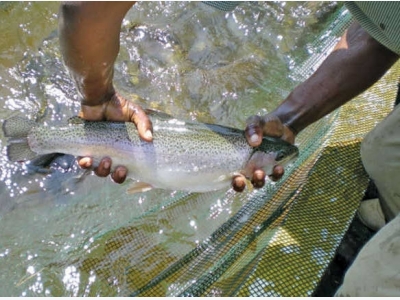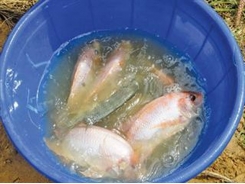Fish farming in Winter

When it comes to temperature levels, warm water fish farms and trout farming are at opposite ends of the spectrum. While tilapia hibernates in winter, trout prefer the cooler weather.
Netting trout from ice-cold water during mid-winter. Trout are active and healthiest at this time of year. Photo: Nicholas James
During cold winter months, we warm water fish farmers can get depressed. Nothing happens in our tanks – the fish won’t feed properly, no courtship or breeding takes place and apart from the fish huddling near the top to benefit from any warmth up there, the farm is dead and miserable!
In contrast, a trout farm is completely the opposite. While your tilapia may be biding time, hibernating until spring, trout love the cold.
They are active, feed boisterously, and adult fish turn their minds to reproduction. Being Northern Hemisphere in origin, and with a love for cool temperatures of around 15°C, trout are in their element during winter in Southern Africa.
For trout, this is breeding season and as the water cools during autumn, eggs ripen within the fattening females and the cock fish become hook-jawed and feisty.
They can then be stripped and spawned and the eggs artificially incubated on screens in cool, well-oxygenated water. Within a few weeks post-spawning, the tanks will be teeming with baby trout.
The advent of warm water periods during this time can spell disaster as the massed small trout demand both high quality water and elevated levels of oxygen, something that rapidly reduces as temperatures rise, especially over 20°C.
Opposite ends
So trout and tilapia are at opposite ends of the spectrum where temperature demands are concerned. Then, can one grow tilapia during summer and trout during winter in the same system? In theory the answer is yes, while in practice, it is not that simple.
The time it takes to rear these to a market size precludes any sort of real ’time-sharing’. Tilapia, which start off life as fingerlings in spring, will only reach a mass of around 300g to 400g by autumn.
Trout, which have over-summered, will come into breeding condition as the water cools to below 16°C, and their fry will be free-swimming by July.
Even if they are well-fed, they will still be only young adults of 125mm to 150mm when the warm weather raises temperatures to uncomfortable levels. Admittedly, they can be stocked into dams and rivers where they may find cooler temperatures to their liking, and grow well all through summer if the water remains well-oxygenated.
Dams that are fed by cool, mountain streams can harbour trout, even at low altitude, as long as the water does not warm to over 23°C, and remains clear and well-oxygenated.
A farm system that can cope with both warm and cold water fish is difficult to devise. Tunnels, that keep temperatures elevated for tilapia, are at odds with the requirements of trout which need structures covered with shade cloth to limit warming.
Open air tanks, with cool, fast-flowing water highly suitable for trout will be a hostile environment for tilapia which prefer slow-moving, warm conditions.
Neither is forgiving of the other’s needs.
Có thể bạn quan tâm
Phần mềm

Phối trộn thức ăn chăn nuôi

Pha dung dịch thủy canh

Định mức cho tôm ăn

Phối trộn phân bón NPK

Xác định tỷ lệ tôm sống

Chuyển đổi đơn vị phân bón

Xác định công suất sục khí

Chuyển đổi đơn vị tôm

Tính diện tích nhà kính

Tính thể tích ao hồ



 Sizing up TiLV and its potential impact on…
Sizing up TiLV and its potential impact on…  Fish breeding do’s & don’ts
Fish breeding do’s & don’ts